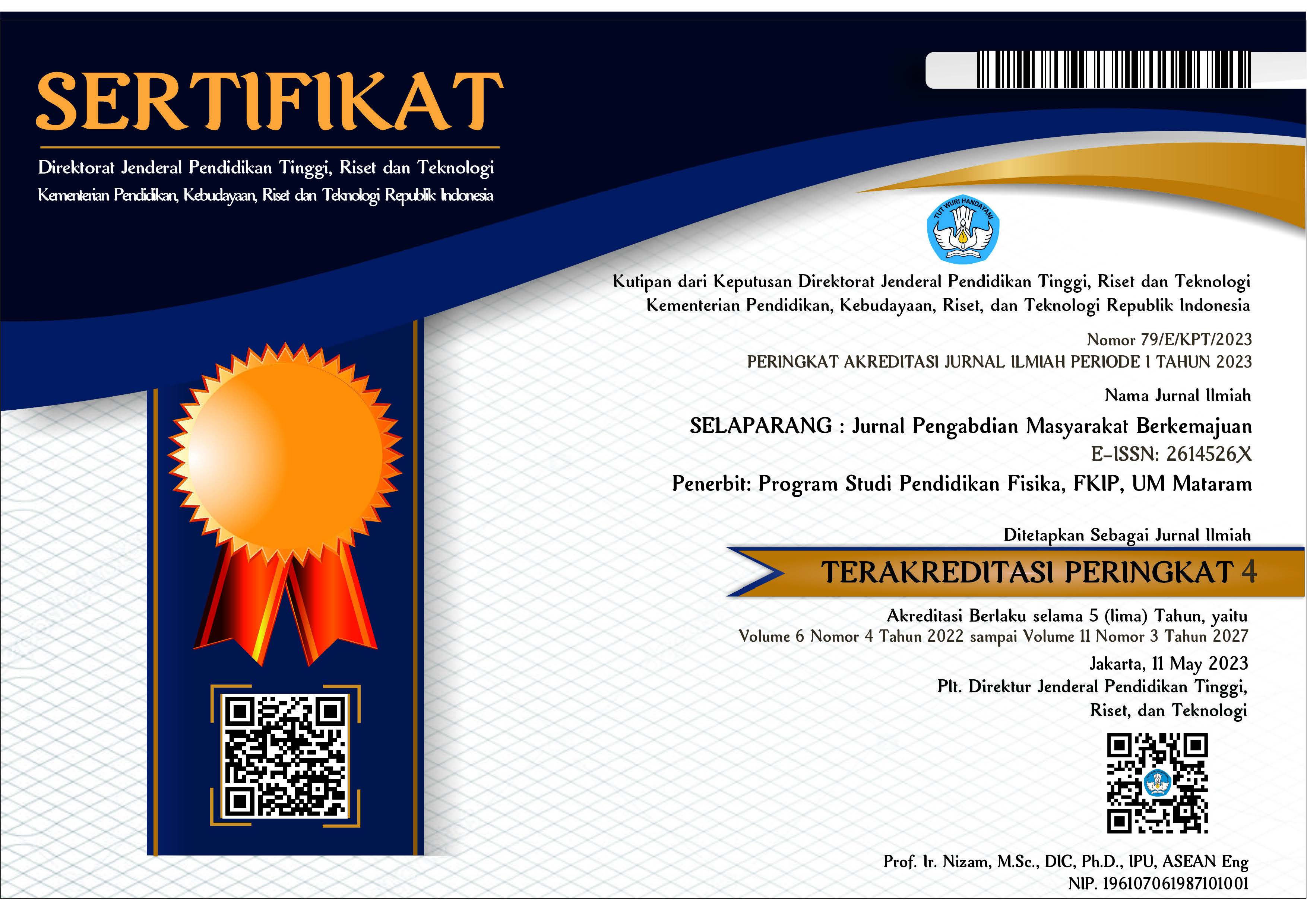REVITALISASI MANAJEMEN AGROEKOSISTEM PADI DI DESA BINAAN SUMBERJAMBE, JEMBER, MELALUI IMPLEMENTASI AGROECOSYTEM ANALYSIS (AESA)
Abstract
ABSTRAK
Masyarakat Desa Sumberjambe, Kecamatan Sumberjambe, Kabupaten Jember sebagian besar merupakan petani komoditi pangan dan hortikultura dengan produksi tinggi. Namun, ancaman penggunaan metode konvensional menjadi ancaman keberlanjutan pertanian di Sumberjambe. AGROECOSYTEM ANALYSIS (AESA) merupakan metode yang dilatih kepada masyarakat untuk memahami pormasalahan serta pemecahan masalah yang ada pada sebuah komunitas pengelola agroekosistem. Tujuan dari kegiatan pengabdian ini adalah melakukan pelatihan pengelolaan OPT untuk mengatasi permasalahan serangan OPT pada Gabungan Kelompok Tani (GAPOKTAN) Desa Sumberjambe, Kabupaten Jember melalui analisis agroekosistem (AESA). Kegiatan pengabdian dilakukan dengan beberapa tahapan. Pertama, dilakukan sosialisasi dan pelatihan identifikasi hama dan musuh alami. Kedua, dilakukan pelatihan dan percontohan teknik monitoring lahan. Ketiga, dilakukan pelatihan dan pendampingan analisis agroekosistem berdasarkan hasil monitoring. Kelima, dilakukan pelatihan dan pendampingan pembuatan APH. Terakhir, dilakukan monitoring dan evaluasi. Terjadi peningkatan yang signifikan dari sebelum dilakukannya pelatihan terhadap musuh alami, hama, dan sumber permasalahan yang ada di kawasan pertanian Sumberjambe. Melalui AESA, juga kemudian diketahui bahwa jamur entomopatogen Beauveria bassiana menjadi salah satu solusi baik untuk mengatasi permasalahan meledaknya hama wereng coklat. Terjadi peningkatan pengetahuan petani setelah proses sosialisasi (meningkat 60%), praktek AESA (meningkat 90%), dan juga pelatihan perbanyakan Beauveria bassiana (meningkat 70%).
Kata kunci: AESA; Beauveria bassiana; entomopatogen; hama; dan musuh alami
ABSTRACT
In the village of Sumberjambe, Sumberjambe District, Jember Regency, the majority of the population are engaged in the cultivation of food crops and horticulture, yielding high production. However, the threat posed by conventional farming methods is endangering the sustainability of agriculture in Sumberjambe. AGROECOSYSTEM ANALYSIS (AESA) is a method that has been imparted to the community to understand the issues and problem-solving within an agroecosystem management community. The objective of this community service activity is to provide training in integrated pest management to address the pest problems faced by the Farmers' Group Association (GAPOKTAN) in Sumberjambe Village, Jember Regency, through agroecosystem analysis (AESA). The community service activities were carried out in several stages. Firstly, there was the socialization and training on pest and natural enemy identification. Secondly, training and field demonstrations of land monitoring techniques were conducted. Thirdly, training and guidance on agroecosystem analysis based on monitoring results were provided. Fifth, training and guidance on the preparation of environmentally friendly pest control measures (APH) were given. Finally, monitoring and evaluation took place. There was a significant improvement observed before and after the training in the knowledge of natural enemies, pests, and the sources of problems in the Sumberjambe agricultural area. Through AESA, it was also discovered that the entomopathogenic fungus Beauveria bassiana is a viable solution to address the issue of brown planthopper infestation. There was an increase in farmers' knowledge after the socialization process (increased by 60%), the practice of AESA (increased by 90%), and also the training on the propagation of Beauveria bassiana (increased by 70%).
Keywords: AESA; beauveria bassiana; entomopathogen; pest; and natural enemies
Keywords
Full Text:
PDFReferences
Badan Pusat Statistik Kabupaten Jember. (2020). Luas Panen Rata-rata Produksi dan Total Produksi Padi Menurut Kecamatan di Kabupaten Jember. pada. www.bps.go.id.
Puech, C., Baudry, J., Joannon, A., Poggi, S., & Aviron, S. (2014). Organic vs. conventional farming dichotomy: does it make sense for natural enemies?. Agriculture, Ecosystems & Environment, 194, 48-57.
Nair, P. R. (2008). Agroecosystem management in the 21st century: it is time for a paradigm shift. Journal of Tropical Agriculture, 46, 1-12.
Budi, G. P. (2021). Beberapa Aspek Pengelolaan OPT Ramah Lingkungan, Suatu Upaya Mendukung Pertanian Berkelanjutan. Proceedings Series on Physical & Formal Sciences, 2, 31-38.
Ganai, M., Khan, Z., & Tabasum, B. (2018). Challenges and constraints in chemical pesticide usage and their solution: A review. International Journal of Fauna and Biological Studies, 5(3), 31-37.
Negi, S., Rani, A., Hu, A. H., & Kumar, S. (2021). Pesticide pollution: management and challenges. In Pesticide Contamination in Freshwater and Soil Environs (pp. 69-88). Apple Academic Press.
Luna, J. M., & House, G. J. (2020). Pest management in sustainable agricultural systems. In Sustainable agricultural systems (pp. 157-173). CRC Press.
Hutubessy, J. I. B. (2021). Pengelolaan Agroekosistem Tanaman Kopi di Desa Wologai Tengah-Kecamatan Detusoko Kabupaten Ende. Panrita Abdi-Jurnal Pengabdian pada Masyarakat, 5(4), 690-697.
García-Llorente, M., Rossignoli, C. M., Di Iacovo, F., & Moruzzo, R. (2016). Social farming in the promotion of social-ecological sustainability in rural and periurban areas. Sustainability, 8(12), 1238.
Van der Werf, H. M., & Petit, J. (2002). Evaluation of the environmental impact of agriculture at the farm level: a comparison and analysis of 12 indicator-based methods. Agriculture, Ecosystems & Environment, 93(1-3), 131-145.
Yasmin, T., Khattak, R., & Ngah, I. (2014). Eco-friendly kitchen gardening by Pakistani rural women developed through a farmer field school participatory approach. Biological agriculture & horticulture, 30(1), 32-41.
Sumikarsih, E., Herlinda, S., & Pujiastuti, Y. (2019). Conidial density and viability of Beauveria bassiana isolates from Java and Sumatra and their virulence against Nilaparvata lugens at different temperatures. AGRIVITA, Journal of Agricultural Science, 41(2), 335-350.
Prithiva, J. N., Ganapathy, N., & Jeyarani, S. (2017). Efficacy of different formulations of Beauveria bassiana (Bb 112) against Bemisia tabaci on tomato. J. Entomol. Zool. Stud, 5(4), 1239-1243.
Vivekanandhan, P., Kavitha, T., Karthi, S., Senthil-Nathan, S., & Shivakumar, M. S. (2018). Toxicity of Beauveria bassiana-28 mycelial extracts on larvae of Culex quinquefasciatus mosquito (Diptera: Culicidae). International journal of environmental research and public health, 15(3), 440.
Russo, M. L., Scorsetti, A. C., Vianna, M. F., Cabello, M., Ferreri, N., & Pelizza, S. (2019). Endophytic effects of Beauveria bassiana on corn (Zea mays) and its herbivore, Rachiplusia nu (Lepidoptera: Noctuidae). Insects, 10(4), 110.
DOI: https://doi.org/10.31764/jpmb.v7i3.17219
Refbacks
- There are currently no refbacks.

This work is licensed under a Creative Commons Attribution-ShareAlike 4.0 International License.
______________________________________________________
Jurnal Selaparang
p-ISSN 2614-5251 || e-ISSN 2614-526X
EDITORIAL OFFICE:



















